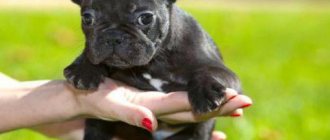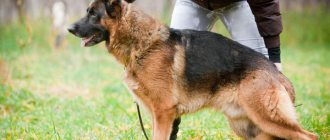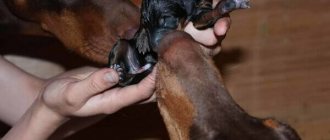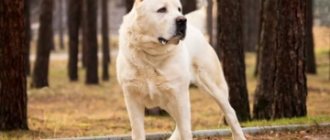11/14/2021 30,706 Diseases and treatment of dogs
Author: Olga
When you touch the nose of a healthy puppy or adult dog, you will probably feel that it is cold and wet. There is nothing unusual about this; unlike in humans, a wet dog’s nose signals the complete health of your pet. But what can the nose tell if it is dry, warm or has an unusual appearance? Why is a dog’s nose wet, and why does it suddenly become hot and dry? Let's talk about this in more detail.
[Hide]
Healthy dog nose
So, a dog who is in good health has a wet and cold nose, which he joyfully pokes at you, inviting you to play or demonstrating his affection. But why is it wet? What are the reasons?
There are several theories to explain this interesting fact. Which one is the most famous? It belongs to zoologist Knut Schmidt-Nielsen. After conducting a scientific experiment, the scientist came to the conclusion that the dog does not have sweat glands. That is why a wet olfactory organ saves the animal from overheating.
If a pet breathes frequently, sticking out its tongue, it cools down and the nose directly participates in this, since droplets of liquid evaporate faster through the nose. Thus, the nasal glands actively participate in the process of heat exchange in a healthy animal. Normally, the dog should not experience any problems in this matter. In addition, the mucus coming out of the nostrils moistens the sensitive earlobe, and while remaining wet and cold, the nose captures odors well. This may be why dogs often rely on their sense of smell, unlike cats, who have keen vision.
Additional symptoms, their explanation and what to do
Below we list additional symptoms, their explanation and what a breeder should do if alarming clinical signs are detected.
Nose is very hot
When a puppy’s nose is very hot and so hot that it can be easily detected with a light touch, he definitely has health problems:
- This is either serious hyperthermia (the puppy is very overheated).
- Sometimes the local body temperature on the nose rises due to dermatitis and eczema (i.e. local diseases of the skin of the nose itself). This is easy to guess by the presence of wounds, cracks, ulcers and other lesions of the skin.
- Or, more likely, your pet's general body temperature is very elevated.
In any case, the baby must be placed in a well-ventilated room (but without drafts). Give the puppy as much water as possible. If the problem is hyperthermia due to overheating, this is enough to normalize the animal’s condition. For local skin lesions, ointments with an antiseptic and healing effect are used (synthomycin liniment, salicylic and tetracycline ointments).
If the temperature persists and the puppy’s condition continues to deteriorate, it is necessary to call a veterinarian.
Nose is very cold
Oddly enough, but in cases where the nose is very cold, everything can be much worse. The fact is that a sharp decrease in body temperature is possible only with a very serious condition of the body and a decrease in the activity of the temperature center in the brain:
- Sepsis.
- Severe poisoning.
- Terminal degree of dehydration.
- Near-death state.
In this case, the puppy is immediately placed in a warm place (but not in the heat), after which a veterinarian should be immediately called.
Dry nose while sleeping
We already wrote above that a dry nose during sleep is completely normal. When a puppy sleeps, his body does not need such intensive cooling, metabolic processes slow down, which is why the nose dries out. You don’t need to do anything; within 30-45 minutes from the moment you wake up, your pet’s nose will return to its normal state on its own.
The puppy doesn't eat anything
When a puppy does not eat anything, and at the same time his nose is completely dry, then this definitely indicates an illness.
If your nose is dry
It is believed that if a dog's nose is deprived of moisture, it means he is sick. But does earlobe dryness always indicate health problems? What are the true reasons for a dog's warm nose?
If you notice a dry nose on a dog, this does not always mean that it is sick.
- If the animal has just woken up, its lobe may be dry and warm. Rejoice - there is no reason to worry.
- The second reason is allergies. It is believed that the animal may have allergic reactions to dishes made from inappropriate materials (for example, plastic). Usually the problem is solved by replacing the plate with a better one and the dog again acquires its usual wet nose.
- Is it too hot outside? This is the reason for a dry nose. Your pet can also feel these unpleasant moments, which is why his nose will become warm. In this case, there is no reason to worry - the lobe can simply be moistened with a calendula solution or plain water.
- Trauma is another reason why you may have a dry earlobe. In this case, it also becomes bubbly. That’s why you can’t click your pet’s nose – this area is too sensitive in a dog.
- Stress and overwork are the reasons why a pet may have a warm nose. This means that the pet just needs to take a breath and calm down, and then the lobe will restore its normal temperature. This is especially true for a puppy who finds himself in an unfamiliar environment.
Vomit
One of the very first symptoms of intestinal and stomach disorders. But it is important to consider that it can be a common occurrence for a dog to greedily swallow bones. In most cases, when a dog vomits, he can eat it back. But if vomiting is accompanied by signs of suffocation and his legs are bent with his head hanging low, then it is a clear sign that he is about to vomit, you should quickly go outside with him and let him breathe fresh air so that he will be released.
All these symptoms may appear gradually and not all at once, or it happens when one is pronounced and the other is completely normal. But at the same time, the number of pathologies may increase.
Hot and dry nose
Everything is much more serious if, in addition to dryness, the dog’s nose becomes hot. This indicates that the pet has a fever and is experiencing a fever.
If there are no other symptoms other than a hot nose, then the animal must simply be overheated.
However, such a symptom may also indicate a dog’s illness, especially if it is accompanied by other signs, such as:
- lethargy;
- strong thirst;
- weakness;
- lack of appetite;
- drowsiness.
What to do?
If your nose is exceptionally warm and there are no signs of illness, nothing needs to be done. Unless you eliminate the reasons that caused this symptom - take the dog to a cool place from the heat, relieve it from stressful situations, replace its dishes. There is nothing complicated here. But when a number of signs are added to the current problem with the nose, in particular, a decrease in appetite, only a veterinarian can help the dog. If you don’t catch it in time, complications and even the death of the animal are possible; you especially need to be vigilant if we are talking about a puppy.
What should a puppy's nose look like normally?
But first you need to talk about what a puppy’s nose should be like normally:
- The skin should be slightly damp and cool.
- The condition of the skin on the nose itself is of great importance. Normally, it is smooth, shiny, and “silky” to the touch. Even if the nose is cool and damp, but it is full of sores, scabs or ulcers, there is no need to talk about health. In any case, such a puppy must be shown to a veterinarian.
- The skin on the nose should be elastic. Its dryness and “parchment” state often indicate illness.
What does a very cold nose mean?
Typically, an “icy” and wet earlobe indicates a decrease in the temperature of the pet’s entire body.
There can be many reasons: from banal hypothermia to serious illness. If your animal has dull eyes, pale gums, or cold ears, this is a reason to visit the veterinarian. It is very possible that some of the dog’s organs are failing.
Now you know why the temperature of a dog’s nose can change. Although the nose is not the most accurate indicator of health, it can indicate that the animal needs close attention. And if you notice changes, do not delay visiting your doctor.
Allergies in dogs
Dogs, like people, are allergic to:
- Flea saliva - manifested by itching and redness in areas, a rash on the skin. Capturing them is not that difficult. They live in exposed areas of skin, on the paws and on the stomach.
- For some types of food this is a rare occurrence. Most often, dogs can be allergic to chicken and beef.
Less often - turkey and duck and rabbit meat.
To eliminate allergies, it is important to first understand the cause. Then change this product to another. If you feed food, you need to change it to hypoallergenic.
- On the external environment - called atopic dermatitis. Dust, mold, grass, these are all sources of allergies. It is impossible to cure, but you can prevent it by washing the floors more often to avoid dust or even replacing the floor with parquet.
Video “The world of our smaller friends”
This video will talk about how dogs see the world through their noses.
Sorry, there are no surveys available at this time.
Was this article helpful?
Thank you for your opinion!
The article was useful. Please share the information with your friends.
Yes (100.00%)
No
X
Please write what is wrong and leave recommendations on the article
Cancel reply
Rate the benefit of the article: Rate the author ( 6 votes, average: 4.67 out of 5)
Discuss the article:
Why do dogs lick their noses?
Why an owner should be the “leader” for his dog
Dogs lick their nose constantly for a variety of reasons. First of all, in this way they independently moisturize it. Licking an animal's nose is a hygienic procedure. The dog cleans it of food debris, dirt and dust that remains after walks.
For your information! It is very important for the dog that the surface of the nose is clean. By licking, she rids the olfactory receptors of accumulated odors. Otherwise, it becomes difficult for the animal to navigate in space.
Regular nose licking is a hygiene procedure for dogs
Normal condition
In a healthy state, the nose should be cool, because when the temperature rises, the mucous membrane quickly dries out and cannot produce secretions. There is an opinion that if a dog’s nose is hot, and not cold and wet, then the pet is not entirely healthy. However, such a condition does not necessarily indicate the presence of malaise.
Why under some circumstances the nose can be dry - you will learn about this further.
We recommend this article:
Biochemical and clinical blood tests in dogs
So, puppies have a dry nose both after active pastime and after sleep. Some time after waking up, the nose becomes wet. Sometimes a dog encounters something and the secretion production is disrupted, and as a result, the nose becomes dry. After a while, secretion production resumes and the condition of the nose will become normal. If the animal is tired, the condition of the mucous membrane worsens. After rest, everything returns to normal.
The mucous membrane also reacts to stress with dryness. Moving to a new place of residence, fright, saying goodbye to the owner - all this leads to a dry nose. After the dog calms down and gets used to the new conditions, everything will return to normal.
The nose may feel warm in an apartment where the heating is intense. To avoid this situation, the air in the room needs to be humidified. The simplest method is to place a bowl of water in the room or place a wet towel on the radiator.
The seventh reason is infections
An increase in body temperature is one of the first signs indicating the development of an inflammatory process in the animal’s body.
As a rule, the main cause is infection. Various viruses and bacteria that damage the cells of the body as a result of their vital activity provoke the development of inflammation. If the infection affects the body in a generalized manner, the temperature rises throughout the body. Fever also affects the condition of your pet’s nose. The most dangerous infectious diseases that threaten the life of animals are canine distemper and rabies.
It is very important to vaccinate your pets in a timely manner, according to the vaccination calendar. Otherwise, the risks of developing distemper or rabies infection increase significantly
Distemper is a rapidly developing disease that can cause death. One of the first symptoms of infection is a dry and hot dog's nose. In addition, disturbances occur throughout the body. Noted:
- severe weakness;
- apathy and depression in the animal;
- discharge of purulent exudate from the nasal passages;
- stool disorder, manifested by diarrhea with foam;
- attacks of nausea and subsequent vomiting;
- refusal to take not only food, but also water.
The second disease is 100% lethal. If carnivore plague can be successfully cured, if a visit to the clinic occurred at the very first signs of the disease, then with rabies it is more and more difficult - it cannot be treated. A sign of a dangerous infection entering the body is a depressed state, dry nose, and photophobia. Already at a later stage, characteristic aggression, fear of hydrophobia and other manifestations of a dangerous viral pathology arise.
Symptoms of tonsillitis.
A symptom that combines both types is pain in the throat. The pain can be both severe and tolerable. The patient experiences severe discomfort while eating and swallowing.
Sore throat is much more severe than a chronic disease and is accompanied by the following symptoms:
- increased body temperature (up to 40°C);
- very severe sore throat;
- enlarged lymph nodes;
- accumulations of pus on the tonsils (plaque, pustules);
- enlarged tonsils;
- headache;
- weakness.
The symptoms and treatment of chronic tonsillitis are somewhat different from the manifestations of tonsillitis. With a chronic disease, the temperature remains at 37°C. A sore throat, cough, and bad breath are added. There is a white coating on the tonsils. The symptoms are less pronounced, since the course of the disease itself is characterized by remissions and exacerbations. A patient suffering from a chronic form of the disease loses his ability to work, gets tired quickly, and loses his appetite. Often a person suffers from insomnia.
What should the owner do?
When making a decision, consider the condition of the pet. If it is satisfactory, then you can help yourself.
At home
Don't panic if there are no alarming symptoms. The consequences of harmless causes go away on their own, so try to relax and observe.
If you feel lethargic and have poor appetite, take your temperature. Minor deviations can be corrected by drinking plenty of fluids, ventilating or wrapping up. Use simple and safe methods, avoiding taking antipyretic drugs - such treatment can aggravate the animal’s condition, so it is better to entrust the choice of medications to a veterinarian.
To eliminate dryness, use a softening ointment or cream with chamomile and calendula. They will prevent cracks from appearing. The same products are suitable for healing wounds after injury.
When should you pay special attention to your dog's health?
Unfortunately, quite often a hot nose is observed in a pet during illness. This includes literally all conditions accompanied by fever and dehydration. But, you need to remember that in this case, dry nose is not the only painful symptom. Usually it is accompanied by other, no less striking signs, indicating the nature of the pathology and the severity of the course. The main ones are:
- lack of appetite and sometimes thirst;
- increased thirst;
- excessive lethargy, refusal to play;
- the desire to go into the darkness, to hide from communication;
- aggression, irritation;
- peeling and cracking of the nasal mucosa, rash around the nostrils;
- nasal discharge - thin or thick, greenish;
- lacrimation, photophobia, sneezing, cough;
- rapid breathing and heart rate;
- signs of fever (over 39 degrees);
- dull matted wool;
- constant skin itching;
- hair loss, bald patches.
The dog should be monitored. If these symptoms increase and the dog feels worse and worse, you should immediately take it to the veterinarian.
There is also a group of signs indicating a dog’s critical condition. When they appear, the animal requires urgent help. If your dog has a dry nose and exhibits one or more of the following signs, he may be saved by taking him to a veterinarian immediately:
- rise in body temperature to a level exceeding 40 degrees;
- lethargy, loss of consciousness;
- the presence of seizures or paresis;
- problems of the gastrointestinal tract (vomiting, diarrhea mixed with blood);
- urinating too often or too rarely;
- inappropriate behavior (strong aggression, fear of hydrophobia, walking in circles);
- pain syndrome (moans, whining).
Types of tonsillitis.
The disease occurs in two forms - acute and chronic. Acute tonsillitis is an illness of an infectious nature and manifests itself in acute inflammation of the tonsil. The cause of exacerbation is staphylococci and streptococci. Acute sore throat in children and adults is also divided into catarrhal, follicular, lacunar, ulcerative-membranous and necrotic.
Chronic tonsillitis is a long-term, persistent inflammatory process in the tonsils. It manifests itself as a consequence of past inflammation, acute respiratory viral infections, dental diseases, and reduced immunity. Chronic exacerbation of the disease in adults and children occurs in three forms: compensated, subcompensated and decompensated. In the compensated form, the disease “dormants”; exacerbation of tonsillitis symptoms occurs infrequently. In the case of a subcompensated form of the disease, exacerbations occur frequently, the disease is severe, and complications are common. The decompensated form is characterized by a long, sluggish course.











